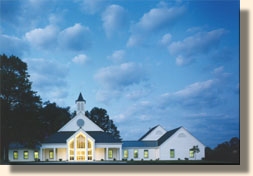 Our approach to historic
preservation is rooted in a solid understanding of classicism. Design in
historic buildings, designs for rehabilitation and designs for new
additions and infill, should respect and dignify the historic architecture
while evoking an interpretation that is understandable to its stewards,
occupants and visitors. Design of new additions will enhance the existing
architecture, maintaining rhythm of fašade, mass, scale and color. The
underlying understanding is one of collaboration with the intent of the
original designer. The product will be an historical rehabilitation which
does not mimic but codifies, does not copy but magnifies. In the end, the
building is telling a story, and we must let that story go on.
Our approach to historic
preservation is rooted in a solid understanding of classicism. Design in
historic buildings, designs for rehabilitation and designs for new
additions and infill, should respect and dignify the historic architecture
while evoking an interpretation that is understandable to its stewards,
occupants and visitors. Design of new additions will enhance the existing
architecture, maintaining rhythm of fašade, mass, scale and color. The
underlying understanding is one of collaboration with the intent of the
original designer. The product will be an historical rehabilitation which
does not mimic but codifies, does not copy but magnifies. In the end, the
building is telling a story, and we must let that story go on.
Historic preservation has influenced new design and construction. People began to wonder why new buildings didn't "feel" as welcoming as the demolished structures they replaced. Since classicism has always been concerned with the relationship between humankind and nature, it has become the design philosophy to which architects have turned when looking for an alternative to the hard edged Modern buildings. The shapes and symbols of classicism are based on the human body as well as other forms drawn from nature. This humane scale and focus on natural materials are a hallmark of the classical tradition, making it a natural ally of the environmental movement as well.
Redefining Form and Function - Design in the Classicist
Tradition
 Most Classical buildings can be recognized by their associated
elements of particular building types: Public/Civil,
Commercial, Liturgical. and Residential. The recognition of building
elements at the surface seems obvious - one can easily differentiate
a house from a church. However, many buildings are also defined
by what they contain or do. A museum is a museum because it contains
a collection. A train station
is defined by its function, and a courthouse represents the embodiment
of law and order. Design throughout history has been a unifying
element in architecture, and it is therefore very important that
the architect can clearly differentiate building types through
his ability to manipulate the classical elements of varying proportions,
scale and order.
Most Classical buildings can be recognized by their associated
elements of particular building types: Public/Civil,
Commercial, Liturgical. and Residential. The recognition of building
elements at the surface seems obvious - one can easily differentiate
a house from a church. However, many buildings are also defined
by what they contain or do. A museum is a museum because it contains
a collection. A train station
is defined by its function, and a courthouse represents the embodiment
of law and order. Design throughout history has been a unifying
element in architecture, and it is therefore very important that
the architect can clearly differentiate building types through
his ability to manipulate the classical elements of varying proportions,
scale and order.
Don A Swofford did not abandon the classical tradition in the
1960's with the rise of Modernism. Rather, we were in the forefront
of the Historic Preservation movement. We were appalled when
witnessing the demolition of the elegant historic buildings in
our communities.  Our involvement in the historic preservation
movement has two inseparable focuses: The first, to maintain
contact with those who have gone before through the buildings
they have left behind, and second, to maintain and design humane
architecture in the built environment.
Our involvement in the historic preservation
movement has two inseparable focuses: The first, to maintain
contact with those who have gone before through the buildings
they have left behind, and second, to maintain and design humane
architecture in the built environment.
Many times our challenge as historic architects is to adapt a building designed for one function to another use (a house may be used as a Bed & Breakfast) or scale (a train station could be adapted for use as a museum or restaurant). Classical design allows an architect to make the difficult transition from one unrelated function to another, such as adapting a large formal space for gathering into an intimate space. Using scale and the appropriate classical orders, skilled architects can not only define building types, but redefine them as well.
For more information, please contact us.